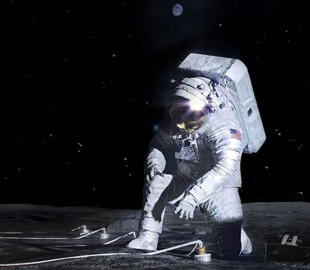It is obvious that not every job can be entrusted to robots. According to NASA, the astronauts of the “Artemis-3” mission first of all, they have to manually install three scientific instruments on the moon, which will then help develop lunar and even Martian programs.
The Artemis-3 mission ("Artemida-3") is currently expected in the fall of 2026. During its implementation, three astronauts should be landed in the region of the south pole of the Moon. This will be the return of man to the Moon after more than 50 years of absence satellite. Man's presence, NASA believes, will enhance scientific discoveries. This will be a new era of satellite research, when man, in the form of astronauts, will personally make his significant contribution to the preparation and conduct of experiments outside the Earth.
The three instruments selected for the first experiments will be used to solve the three scientific tasks of the Artemis program: to help with the understanding of geological processes in the bowels of the planet, to find out the nature and origin of volatile substances in the polar zone of the Moon, as well as to study and reduce the risks of “related to intelligence. The devices were specially chosen with the condition that the installation of each of them (and this will be a whole complex of sensors, base stations, etc.) will require the participation of astronauts.
The first complex of instruments will be the Lunar Environment Monitoring Station (LEMS). This is a compact autonomous seismometric complex designed to carry out continuous long-term monitoring of the seismic situation, namely soil movement due to lunar tremors in the south polar region of the Moon. The device will also clarify the structure of the crust and mantle of the Moon in the region of control.
Observations using the LEMS station will add valuable information for modeling the formation and evolution of the Moon. Previously, the LEMS development program received the necessary funding from NASA for four years. The station is designed to operate on the surface of the Moon for three months to two years and can become a key station future global lunar geophysical network. The development of the LEMS complex is led by Dr. Mehdi Benna from the University of Maryland, Baltimore County.
The complex called “The influence of the moon on agricultural flora” or LEAF will investigate the influence of the lunar surface environment on crops grown in space. The LEAF complex will be the first experiment to observe photosynthesis, growth and systemic responses of plants to stress in conditions of cosmic radiation and weakened gravity. The data measured by LEAF on plant growth and development, along with environmental parameters, will help scientists understand the prospects of using plants grown on the moon for both human nutrition and life support on the moon and beyond. The LEAF project is led by Christine Escobar of Space Lab Technologies in Boulder, Colorado.
The third device — lunar dielectric analyzer (LDA) — will measure the ability of the regolith to spread an electric field, which will become a key parameter in the search for lunar volatiles, especially ice. ice deposits. The LDA program is carried out in Japan with the support of JAXA. The project is led by Dr. Hideaki Miyamoto from the University of Tokyo.
«These three scientific instruments will be our first opportunity after ”Apollo” to use the unique capabilities of human explorers to transform lunar science, — said Joel Kearns (Joel Kearns), deputy assistant administrator for research at NASA's Science Mission Directorate in Washington. — These payloads mark our first steps toward implementing the recommendations for high-priority science outlined in the Artemis III Science Definition Panel report.

